Outlive Preview
We play a nearly-complete build of this strategy game and report with hands-on impressions and screenshots.
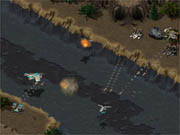
Real-time strategy games seem to be making a resurgence in 2001, with Black & White and Warcraft III slated to come out and several other RTS games on the horizon. One such game is Outlive, from Continuum Entertainment and Take 2 Interactive. These days, it takes a lot to distinguish a strategy game from its competitors. Some games opt to try out new features and innovative gameplay. When developers go the innovative route, we get games like Myth and Sacrifice. Of course, developers can also go the complete opposite way and decide to simply clone a proven winner. Judging by the beta we've been playing, it looks like Outlive takes the latter route, but at least it's cloning a blockbuster like Starcraft in its attempts to bring us a new brand of gameplay.
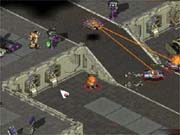
Outlive continues a long-standing trend of the postapocalyptic setting, where Earth is all but doomed, with two factions fighting to see who will survive the impending destruction of Earth. In this case, the planet is woefully overcrowded. The population has exploded, and all of Earth's natural resources have been depleted. The scarcity of resources has given rise to various terrorist factions that have resorted to violence to hoard the last remaining bits of fuel and food. Besieged by revolutionaries and a paucity of natural resources, the governments of the world have decided to unite under one banner. The newly formed World Council then goes on a two-pronged offensive. First, it imposes a form of martial law to eradicate all terrorist factions. Second, it devises a space program called Outlive to comb through the entire solar system looking for mineral resources on planets and moons in the solar system. Even as the operation to quell terrorism rages on, the world government decides that Titan meets all requirements, being rich in all the resources that Earth is lacking. Unfortunately, this moon of Saturn has a toxic atmosphere and a harsh environment, which preclude any human colony from surviving there. So the world government has tasked two competing agencies with developing ways to brave the Titan elements and begin mining the moon. One faction decides to create mutated humans that can survive in the Titan atmosphere, while another faction opts for robots instead. Stunned by the World Council's decision to ravage the human genome and create mutated monstrosities, one prominent terrorist group called the Liberty Army declares war on the World Council. Amidst all this turmoil, with the experiments in both the robotics and mutation teams coming to a close, the game begins.
Campaign and Graphics

In Outlive, there are two sides--the humans and the robots--although there are three campaigns. You'll begin play on with the human campaign, working to help the World Council speed its Outlive program along. Titan has to be mined for Earth to survive, and so you are tasked with ensuring that the two teams finish their research and begin the march toward Titan. However, during the first few missions of the human campaign it becomes clear that other organizations don't want the Outlive program to proceed. The Liberty Army has sabotaged the experiments in genetic mutations, fearing the results of those experiments. Perhaps rightly so, because the monsters that result from the genetic manipulation are marauding beasts. The first time you see one in the game, you'll be shocked by just how much more powerful it is than your regular infantry or tank. Soon, you have to uncover the conspiracy that has set up the mutation experiments to fail. Is it truly the work of the Liberty Army? Or is the robotics team secretly stacking the deck so that their robots win the contract instead of the mutants?
By the time you start the robot campaign, which picks up where the human campaign ends, that answer will be abundantly clear. Although by this time, you'll discover that the different factions aren't always what they seem. The campaigns aren't black and white, and you'll start to ask yourself whether you're playing for the good guys or not. There is a final third campaign called the cooperative campaign, which follows the robot campaign. Power has once again shifted, and now human and robot freedom fighters must ally to stop the real threat to world peace. The scenarios themselves don't seem to be too interesting, at least not the beginning missions we played. You'll have to find lost scientists, although they always seem to just be standing around on the landscape. There is also the standard destroy-the-enemy mission, where you have to obliterate the enemy base to proceed.
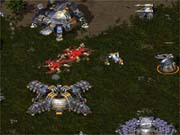
When you first boot up this game, its resemblance to Starcraft will be striking. The tiles in the tutorial seem almost identical to the space station tiles in Starcraft. The rest of the terrain, though, does have its own look. In the beta, the graphics were adequate, and the units were all easily discernable.
From the sounds of this build, the audio will generate the same excitement as the graphics. Here also the game tries even harder to be like Starcraft. The flamethrower unit in Outlive, for example, has the same fascination for fire that the firebat in Starcraft has. There is a certain humor injected into each unit, as it barks out affirmative orders to you when you control it. However, the humor here seems juvenile and at times stereotypical. The human transport unit, for example, has a very fake and offensive Indian accent, almost as if the designers are trying to say that the transport is like...perhaps a taxicab? The dominator tank has a woman muttering dominatrix-style commentary at you. All the voice-overs for the units sound like the musings of a grade-school gang--cheap laughs that bomb horribly. The robots at least sound better. Let's hope these voices are just placeholders and that the units will have more believable voices in the final game or, better yet, won't say anything at all.
Gameplay
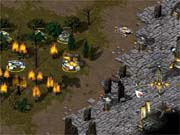
The gameplay itself is straightforward and reminiscent of other RTS games on the market. There are differences in the units for the two sides, but the resource management and tech trees are very much the same. You have to mine minerals from iron or uranium mines, using harvesters, although there is a tech upgrade that lets you build a self-extracting mine that gives you credits without your having to haul minerals back to your refinery. You'll need power plants to give power to your buildings. Without them, buildings will operate sluggishly, research will slow to a crawl, units will be produced at a slower rate, and so on. The two sides use different power--robots use solar power and humans use wind power. More importantly, humans must build their power plants next to their buildings, while the robots don't have to.
The credits you gain through mining are then used to build units or research upgrades at the research center. You can research special abilities for certain units, get weapons and armor upgrades, and improve the efficiency of your various buildings.
There are a few noteworthy features in Outlive thus far. The interface is incredibly easy to use, and the game is easy to learn. Some of that is due to its similarity to other RTS games, but the tutorial is smart and the interface is very intuitive. There is an extensive waypoint system that lets you lay down multiple paths with various waypoints. All you have to do to tell a unit to walk along the paths you set up is to select a unit and then right-click on the starting point of the path. The unit will then follow the path you set up. You can thus create many highways crisscrossing the map to ensure easy and fast navigation of the terrain. Other interface options include the ability to designate retreat and help parameters. You can also set when a unit will retreat to base by modifying its damage tolerance; at its limit, which you set, it will flee. You can likewise expand or contract its help radius, which tells the unit how far to go in helping a friendly unit under fire.
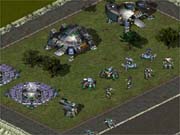
The environment affects gameplay somewhat in Outlive. Trees can be shot at and put on fire. Fires can subsequently spread to other trees and even buildings. Elevation plays a role in battle, as units firing from low ground to high ground do less damage. Radiation, stemming from nuclear power plants and uranium mines, also can harm units and buildings. The abominables, those creatures formed by the World Council's genetic experiments, also occasionally appear on the land, wandering around the map. They are often docile but can also turn on players and start attacking at a moment's notice.
Another gameplay feature is espionage. By building an intelligence center and then investing in espionage technology, you can perform a variety of functions to give you an advantage over your opponent. You can reveal pieces of the map, monitor other players, steal research, paralyze enemy buildings, and even defuse or redirect enemy nuclear missiles.
Human Units
Although the two sides in Outlive are similar in play styles, they do have different units. Here is a brief description of the human units in the game.
Builder: This is the most basic vehicle for the human side. It has puny weapons because its primary function is to build the human buildings.
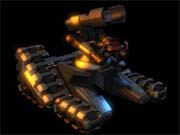
Gatherer: Although armed with machine guns, the gatherer is designed to harvest minerals at mines once an ore extractor has been built atop the mine. Gatherers can also harvest the scrap metal left on the map from destroyed vehicles.
Explorer: This is the basic military unit of the human side, with modest firepower. It has two special upgrades. Nitro lets it move at double speed for a brief duration, and time bomb lets it plant a timed explosive on the map.
Dominator: This tanklike unit can fire at air and ground units and has heavy firepower. Its two abilities are incubate and dominate. With incubate, it can infect an abominable with a parasite that soon kills the host and emerges as a flying vampire unit. Dominate lets the dominator take control of enemy units.
Flamethrower: This unit has a short range and can only affect ground targets, but the continuous stream of fire quickly melts all enemy vehicles.
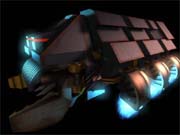
Transporter: This basic flying unit has minor armament, but it is used to transport units. It can be upgraded to carry heavier loads and to even perform airstrikes.
Chopper: This unit starts out as a good air-to-air attacker, but it can be upgraded with air-to-ground missiles that make it deadly against ground targets.
Fighter: The fighter is the ultimate aircraft, delivering devastating firepower to air and ground targets. It can be upgraded with a stealth mode that lets it cloak, as well as with air-to-air guided missiles that can home in on enemy aircraft.
Heavy tank: This is the best ground unit the humans can field. It has a pounding ground attack that quickly annihilates all enemy vehicles. Its special ability is invulnerability, which makes it immune to all attacks for a brief duration.
Robot Units
The robots begin as an experiment but soon take on a life of their own. They have some advantages over the humans. They can build anywhere, not needing to place their structures near power plants, and they also seem to be a little sturdier. Here is a rundown of some of their units.
Morpher: Instead of constructing buildings as the human builder does, the morpher turns into a building, much as the Zerg larvae do in Starcraft.
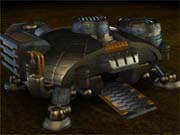
Marauder: This unit is used to harvest minerals, just like the human gatherer.
Raider: This is the basic robot attack unit. It is analogous to the human explorer, but it fires a plasma cannon and can camouflage itself for a limited duration as an abominable.
Twister: This is the robot side's transport unit. It has a plasma cannon attack and can be upgraded to carry heavier loads, but its best upgrade is the teleport ability, which lets it and its cargo teleport vast distances across the map.
Electro: This mechlike unit is more powerful than its dominator counterpart, firing bolts of electricity at its targets. The electro's special abilities let it steal energy from enemy power plants and also fire a ring of electric energy called a nova that damages all enemy units and buildings in the area of effect.
Chaos: This ultimate land vehicle fires giant projectiles that detonate their target, creating a sphere of debris that damages all nearby units. It can also envelop itself in a cloud of radiation that damages enemy units.
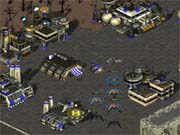
Thunder: This aircraft is a bomber that fires a sonic cone at the ground, disrupting and destroying all ground vehicles in its path. With its special ability, it can activate a force field that protects it from attack.
Avenger: The avenger is the pinnacle of robotic invention. It can attack ground targets with its photon torpedoes and air targets with its laser cannon. It also can be upgraded with a force field.
Outlive is a game that will be very familiar to any fan of real-time strategy games. The beta we played is feature-complete and nearly bug-free, indicating that the game is ready to be shipped. It remains to be seen whether gamers will want to try out a game that basically follows the same formula as other games before it, but Continuum hopes that the game's good qualities will present enough of a new challenge to interest gamers eager for their next real-time strategy fix.
Got a news tip or want to contact us directly? Email news@gamespot.com
Join the conversation